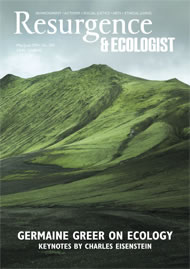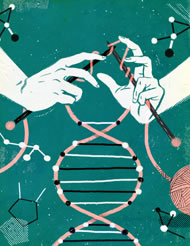Science recognises that stress is directly responsible for up to 90% of illness. In response to stress, the body shuts down growth processes, inhibits immune function and restricts executive conscious processing, collectively impairing the health of our bodies and our performance in life. Stress is especially exacerbated when individuals perceive themselves to be powerless in facing impending challenges.
A particularly disempowering and stress-provoking belief held by the public is the notion that genes control biology and, to a large extent, the character of life. From early school through basic college courses, the media, and personal experience with family lineages, the public has been imbued with a belief in genetic determinism – the notion that genes turn on and off and control our fate.
Since, as far as we know, we did not pick our genes and we can’t change them if we don’t like our traits, we perceive ourselves as “victims of heredity”. If a disease (e.g., cancer, diabetes, heart disease) or dysfunctional trait (e.g., Alzheimer’s, ADHD, depression) is running in a family, we presume it’s due to those inherited genes and that it is our genetic inheritance that will cast our fate as future ‘victims’ when we relinquish power over life to the DNA.
Revolutionary new thinking in physics and biology is undermining old myths and rewriting civilisation’s ‘truths’. Since 1990, science has dramatically veered away from its belief in genetic determinism with the founding of the new field epigenetics, which is the science of how environment controls genes.
Emphasising the Greek prefix epi- meaning ‘above’, the science of epigenetic control literally translates as ‘control above the genes’. In departing from the notion of genes controlling life, epigenetic science emphasises that environment, and more specifically, our perception of the environment, as the factors that actually control gene activity. While conventional belief in genetic determinism implies victimisation, epigenetic science offers insight to mastery over life, since we ultimately control our gene-regulating environment and perceptions.
Epigenetic science upends conventional beliefs and prompts a complete re-evaluation of life as we know it. Epigenetics begs the question, “If we are the ones that control our genes and lives, why is this world so rife with disease and ecological destruction?” More importantly, “What can we do about it?”
To provide further insight into these conundrums, let’s travel back some 40 years to when I was teaching medical students genetic determinism whilst carrying out research on muscular dystrophy and conducting a series of experiments that pioneered the new science of epigenetics. I was cloning multi-potential, embryo-like stem cells, placing a single stem cell in a culture dish by itself. Cultured stem cells divide every 10-12 hours. After two weeks, the cultures contain thousands of genetically identical cells, since all were derived from the same parent cell.
Cells were split into three groups, each inoculated into its own tissue culture dish. A different version of culture medium containing a unique blend of chemical ingredients was introduced into each of the three dishes. Culture medium provides the cells’ ‘environment’. In one dish, cells formed bone, in the second dish cells formed muscle, and in the third, cells formed fat cells.
The big question addressed by this experiment was: “What controls the fate of the cells?” Since all cells were genetically identical, the answer was a no-brainer – the environment controls the fate of cells.
For example, cells grown in what is a less than optimal environment get sick and those cultures die off. To ‘heal’ cells, we did not resort to drugs. We simply returned them to a healthy environment and they spontaneously recovered and flourished. This research revealed that cells adjust their genetics and behaviour to become structural and physiologic complements to their environment.
The culture medium environment represented the factor ‘above the gene’ that controlled the fate of my cells. Culture medium is the cell biologists’ synthetic equivalent of the blood environment that normally nourishes body cells. But how do those findings in stem cell cultures relate to you? To understand, we must first correct a general misperception: While we perceive of humans as single organisms, in reality we are ‘skin-covered petri dishes’ containing approximately 50 trillion cells. Cells are the actual ‘single’ organisms; humans by definition are ‘communities’ of cells.
Epigenetic science recognises that the chemistry of blood, the body’s ‘culture medium’, shapes our genes and behavior. This naturally leads to the question, “What controls the blood’s composition?” Answer: “The brain, which is the body’s ‘chemist’.” Neurochemicals secreted into the blood coordinate our body’s cellular activities in response to our perceptions and emotions.
For example, if you open your eyes and see someone you love, your brain releases into the blood dopamine, oxytocin and growth hormone; neuro-secretions that enhance cell vitality. Hence people ‘glow’ when they’re in love. In contrast, if you open your eyes and see something that threatens you, your brain secretes stress hormones and inflammatory agents. Blood with these neurochemicals in chronic stress conditions will shut down normal cell function and lead to cell death. Hence, stress kills.
Consequently, the top rung of the epigenetic control ladder, the factor that controls the character of neurochemicals released by the brain, is the activity of the mind. Epigenetics completely rewrites the limiting beliefs of genetic control, for the new science emphasises the mind in controlling genes and behaviour. This insight reveals we are ‘masters’ of our fate for we are free to change our minds.
More than a few readers may now be thinking, “Mastery? This can’t be true … my mind would not have created this disease or that behaviour!” To understand this apparent anomaly and recapture control over our lives, we must first recognise that the mind is comprised of two interdependent elements, the conscious and subconscious minds, each expressing different functions and different ways of learning.
The conscious mind, representing your uniqueness, your source or your spirit, is the creative mind. Conscious creativity is the source of our wishes, desires and aspirations. In contrast, the subconscious mind is primarily a powerful record-playback device expressing little creativity. It is responsible for automatically and unconsciously engaging instincts and complex learned behaviours, programmed as habits.
The subconscious mind’s primary behavioural habits and responses to life, including beliefs about self-identity, do not necessarily express our wishes and desires. Between late fetal development and seven years of age, fundamental behavioural programmes controlling life are directly downloaded into the subconscious mind simply by observing the behaviour of parents, siblings, and community.
To accommodate the massive behavioural download during its development, a child’s brain predominantly operates at theta EEG frequencies – a functional state associated with hypnosis. Neurologically, infants acquire a behavioural repertoire by observing the behaviour of others. Passive hypnosis downloads enable an infant to acquire thousands of behavioural ‘rules’ necessary for both survival and becoming a functional member of a family and community. Unfortunately, psychologists suggest that 70% or more of behaviours downloaded into the subconscious during our developmental years are negative, disempowering and self-sabotaging.
If mind is programming our lives, why do most people have difficulty in manifesting their life expectations? The primary reason is that we believe we are controlling our lives with conscious mind wishes and aspirations. Wrong. Neuroscience reveals the conscious mind controls cognitive functions from only 1–5% of the time; consequently, 95–99% of our behaviour is derived from our subconscious programmes.
The reason for this functional imbalance is related to a unique property of the conscious mind … it can think. While busy thinking, the conscious mind is not mindful of the current moment. When the conscious mind’s attention is diverted, behavioural control is automatically defaulted to subconscious programmes … which principally express the behaviours of ‘others’.
A conscious mind engaged in thought rarely observes behaviour derived from default subconscious programmes. Since the majority of its fundamental behavioural programmes are deemed disempowering, we unconsciously sabotage ourselves most of the time. Unaware of the subconscious mind’s invisible participation, we unfortunately perceive ourselves as victims, blaming the Universe or indeed others for our own shortcomings.
Knowledge of how developmental subconscious programmes shape our lives is not new. Over 500 years, Jesuits have boasted, “Give me a child until it is six or seven years old and it will belong to the Church for the rest of its life.” They knew the first seven years of programming determines your life’s path in spite of your conscious wishes and desires. This knowledge has not been lost on those who have since shaped the world’s stage.
As illustrated in the Hollywood movie, The Matrix, we have all been programmed! What would life be like if we all took the movie’s “red pill” and got out of the “programme”? How would an empowered life unfold without the negative misperceptions acquired in developmental programming? Interestingly, most have experienced this amazing state. Have you ever fallen in love and enjoyed what I refer to as the “honeymoon effect,” a state of glowing health, overflowing energy, and life experiences resembling Heaven-on-Earth?
Science recently recognised people in this state of love keep their conscious minds present (mindful) approximately 90% of the time. When operating from mindfulness, life experiences are created using the conscious mind’s wishes and desires, and only infrequently do we default to limiting subconscious programmes. The honeymoon state is not an accident, but a personal creation derived from the conscious mind’s control of cognitive behaviour.
Unfortunately for most, the honeymoon experience returns to ‘regular’ life, or even divorce, when the conscious mind becomes engaged with the busy-ness of life again. For that is when we unconsciously default to negative subconscious behaviours that sabotage the honeymoon experience.
Replacing our limiting subconscious programmes with behaviours expressing our wishes and desires would lead to a perpetual state of Heaven-on-Earth for billions of global citizens. The good news is that those disempowering subconscious programmes can readily be rewritten. There are four fundamental ways to install new subconscious programmes: (1) through hypnosis, the way we learned the programmes in the first seven years of life; (2) through repetition and the creation of ‘habits’, the primary way we acquire subconscious programmes after age seven; (3) an individual may rapidly rewrite programmes after an overwhelming or psychologically-traumatising life experience (e.g., being diagnosed with a terminal illness); lastly, (4) there are new belief modification programmes, some known as energy psychology, that engage the brain’s super-learning processes, allowing programmes to be changed in minutes.
Epigenetics sheds the illusion of ‘victimhood’ and offers ‘mastery’ in the unfolding of our lives. The new science provides knowledge of ‘self’, which by definition, translates as ‘self-empowerment’. The cultural advantage offered by epigenetics is fundamental in advancing human evolution.
For resources that facilitate rewriting limiting subconscious beliefs, visit: www.brucelipton.com







